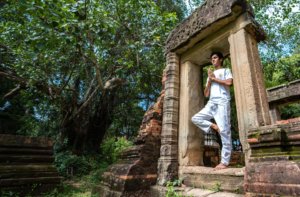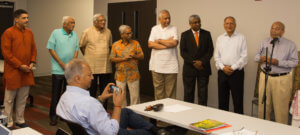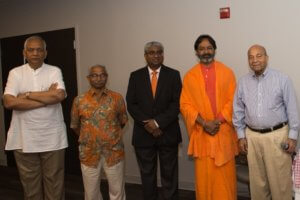This is the first part of a two-part blog on the qualities of an Adhikāri Sādhaka—an aspirant for the knowledge of Brahman. A close reading of the Praṣna and Katha Upaniṣads reveals the ethical and intellectual qualities required for this pursuit. Such qualifications are achieved through profound effort and commitment and not by the chance circumstances of one’s birth or social condition.

About the eligibility of students who seek to know the knowledge of Brahman
Exploring The Upaniṣadic Understanding Of Adhikāri Sādhaka
Rooted in Saṃskṛtam, adhikāri means one who is empowered, authorized, qualified, fit for, and entitled to. Sādhaka, derived from the root word ‘sadh,’ means ‘to accomplish’ and refers to an efficient or skillful person. Therefore, an adhikāri sādhaka is not just any student but one who is qualified to receive the knowledge of Brahman.
In his commentary on Bhagavad Gita, Swami Dayananda Saraswati speaks of three types of students:
- A vidyārthi is one who wishes to know but does not necessarily make an effort to find out
- An antevāsi makes an effort by entering studies or a Gurukul but does not grasp the teachings effectively
- A śiṣya is one who is qualified to study and deserves to be taught because of his direction and commitment to the study
Based on this, we see alignment between the definitions of a śiṣya and an adhikāri sādhaka.
What are the qualifications for the study of Brahman?
Every Upaniṣad begins with a Śānti Pāth. Many of the mantras deal with the well-being of the mind and body before delving into philosophical discussions. At first glance, one thinks that the student is seeking a benediction. But, upon further contemplation, one realizes that the śloka is establishing the requirements for the study.
Anyone on the spiritual journey must nourish the body and mind to be instruments of learning. There can be no proper transfer of knowledge if this is not done. It is not just a prayer but a prerequisite, as a healthy body and mind increase one’s energy, ability, and capacity to know.
While those who experience ill health are not disqualified from the pursuit of this knowledge, their unwellness does pose apparent challenges. Focus, concentration, and stamina can be impeded when the mind pulls the intellect toward the distractions caused by bodily aches or mental diversions.
By closely contemplating the following Śānti Pāth, one can extrapolate various detailed requirements for an adhikāri sādhaka to pursue this path.
“ॐ भद्रं कर्णेभिः शृणुयाम देवा भद्रं पश्येमाक्षभिर्यजत्राः ।
स्थिरैरङ्गैस्तुष्तुवासस्तनूभिर्व्यशेम देवहितं यदायुः॥
Aum, may we, O Gods, hear what is auspicious with our ears, oh you, who are worthy of worship, may we see with our eyes what is auspicious. May we enjoy the life allotted to us by the gods, offering praise, with our bodies strong of limbs.”
~ Prashna Upanishad, Śānti Pāth
- AUM: Aum is the Supreme Brahman, manifest and un-manifest. Therefore, the student first acknowledges that there is a Reality greater than the individual self.
- May we: The student desires the well-being of humankind, not just himself. Moving beyond the individual to the whole—from the particular to the general—signifies the dissolution of the ego. He understands that the well-being of all means the welfare of the one. This is a second requirement of an adhikāri sādhaka.
- Oh Gods: The student recognizes the Devtas as personifications of the senses. He can direct them (through karmas) and not just respond to them.
- Hear what is auspicious with our ears: The student understands that the senses and sense organs are tools for elevation, going beyond sense enjoyment.
- Oh, you who are worthy of worship: The student also understands that the senses are worthy of worship, not that he becomes their servant, but that he takes care of them and respects them as instruments for progression. The senses are not neglected because they are phenomenal.
- May we see with our eyes what is auspicious: The student regulates himself and has healthy consumption for the mind and the body—consumption that is not driven by the senses but by the desire for complete well-being.
- May we enjoy the life allotted to us by the gods: The student understands that while pursuing knowledge is a yajña (sacrifice), it does not mean a life of torment or deprivation. He carries within him the mindset of joy.
- Offering praise: The student understands that Bhagavān is the karma-phala-dāta and considers everything to be prasādam. He offers praise with an attitude of gratitude.
- With our bodies strong of limbs: He understands that the śarīra is the vehicle of the ātma, and a strong body is to be used for worship, not simply for pursuits of kāma.
It is noteworthy that gender does not restrict one from the pursuit of knowledge of Brahman. While male students typically populated the Gurukuls and were prominent drivers of the conversations within the Upaniṣads, questions from women such as Maitreyi and Gargi in the Bṛhadāranyaka Upaniṣad, which lead to elaborate discussions on metaphysics, validate them as worthy adhikāri sādhakas.
This knowledge is not restricted to seekers belonging to any particular varna or societal status. In particular, “Brahma jānāti iti brāhmaṇaḥ” is sufficient as a qualification within itself.
Even age is not a deterrent illustrated by the Nachiketa-Yama dialogue in the Kathopaniṣad.
The Upaniṣad’s illustration of an ideal Adhikāri Sādhaka
To see a true example of an ideal student, one needs to look no further than Nachiketa in the Kathopaniṣad. The child goes to Yama (death)—the most qualified Guru—and requests that he imparts to him the highest knowledge (parā vidya). Nachiketa doesn’t ask for freedom from death (liberation) because his great intelligence has already allowed him to achieve this through his other boon. He asks for knowledge, perhaps for the benefit of humankind.
Nachiketa’s character is resultant of the Sādhana Chatuṣṭaya (four means of practice). He has the ability to apply viveka to discern between the real and unreal, permanent and temporary, self and non-self. Consequently, Nachiketa has developed vairāgya and has no attachment to worldly things despite the many enticements presented to him. His mumukṣutvam, or intense longing for enlightenment, keeps him determined towards the relentless pursuit of knowledge of Brahman.
Consequently, Nachiketa is the epitome of Ṣaṭsampat or six virtues, which seem to come to him as second nature. These merits support the sādhaka’s journey towards antaḥkaraṇa śuddhi by helping to purify and stabilize the mind, emotions, and thoughts.
Nachiketa demonstrates:
- Śama: Tranquility, peace of mind – he does not get carried away by his father’s declaration that he would be given to Yama.
- Dama – the child has complete control over his senses and does not succumb to the material temptations offered by Yama.
- Uparati – He has no desire for worldly pursuits and pleasures but remains persistent in his thirst for higher knowledge.
- Titikṣa – Nachiketa exemplifies forbearance and tolerance. He patiently awaits Yama’s return for three days to get his questions answered.
- Śraddha – The child exhibits an intense sense of clarity (or desire for clarity) and has faith that his Guru (Yama) will provide it.
- Samādhāna – Nachiketa shows concentration and steadiness, making him the ideal student. He is unequivocal on the questions he wants answered and is not swayed by the temptation for anything else.
What prevents one from becoming an Adhikāri Sādhaka?
Kathopaniṣad 1.2.24 says:
“नाविरतो दुश्चरितान्नाशान्तो नासमाहितः । नाशान्तमानसो वाऽपि प्रज्ञानेनैनमाप्नुयात् ॥
One who has not desisted from bad conduct, whose senses are not under control, whose mind is not concentrated, whose mind is not free from anxiety cannot attain this self through knowledge.”
Adhikāri sādhaka status is not achieved by chance or accident. Knowledge is not fully received without profound effort and commitment. Unless one is intentional and determined to do what is necessary, parā vidya and its resultant experience of the Self will not be achieved. There is no chance of knowledge of Brahman if one chooses an adharmic life, or one consumed with the relentless pursuit of sense desires. There must be a deliberate effort towards Antaḥkaraṇa śuddhi as the student prepares for the knowledge of the Self.
1Bhagavad Gita: Home Study Course, Chapter 2 verse 7, Swami Dayananda Saraswati
2Brihadaranyaka 2.4.3
3Brihadaranyaka 3.6.1
4Brahma jānāti iti brāhmaṇaḥ – One who knows and realizes Brahman, the Absolute Truth, he is called Brāhmaṇa. https://prabhupadavani.org/transcriptions/bhagavad-gītā-41213
5Kathopanishad 1.1.1 onwards
6Kathopanishad 1.1.20
7Antahkarna Shudhi, Viveka, Vairagya, Mumukshutva










